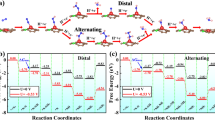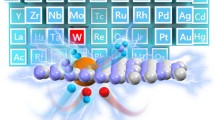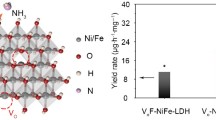Abstract
Synthesis of ammonia gas through environmental protection and low-cost electrocatalysis is one of the ways to solve the current human energy problems. Herein, through the study of density functional theory (DFT), a series of transition metal single atoms are embedded in the defect-containing h-BN to construct a TM@B2N2 (TM = Ti–Zn, Nb–Ag) two-dimensional nanostructure. The activation effect of these single-atom catalysts on NO molecules and the electrochemical performance of catalyzing NO reduction reaction (NORR) were explored. All reaction pathways are studied in detail, and competition between hydrogen proton and ammonia (NH3) oxidation with NORRs is also explored. Among the 16 transition metal atoms we studied, the intercalation of Pb atom into h-BN has the best catalytic activity. The reaction rate-limiting potential of NORR is only 0.55 eV, and the surface HER reaction and ammonia oxidation can be effectively inhibited. It is hoped that our research can further promote the application of h-BN in the field of catalysis and provide some guidance for experimental workers in the field of ammonia synthesis.
Graphical abstract

摘要
通过环保、低成本的电催化合成氨是解决当前人类能源问题的途径之一。在本研究中,通过 密度泛函理论的研究,将一系列过渡金属单原子嵌入到含有缺陷的h-BN 中,构建了 TM@B2N2(TM=Ti‒Zn,Nb‒Ag)二维纳米结构。研究了这些单原子催化剂对NO 分子的活 化作用以及催化NO 还原反应(NORR)的电化学性能。详细研究了所有反应途径,探讨了 氢质子和氨(NH3)氧化与 NORR 反应之间的竞争。在我们研究的16 个过渡金属原子中, Pb 原子嵌入h-BN 的催化活性最好。NORR 的反应限速电位仅为0.55 eV,同时可有效抑 制表面HER 反应和氨氧化。希望我们的研究能够进一步推动h-BN 在催化领域的应用,为 合成氨领域的实验工作者提供一些指导。






Similar content being viewed by others
References
Legare MA, Belanger-Chabot G, Dewhurst RD, Welz E, Krummenacher I, Engels B, Braunschweig H. Nitrogen fixation and reduction at boron. Science. 2018;359(6378):896. https://doi.org/10.1126/science.aaq1684.
Chun HJ, Apaja V, Clayborne A, Honkala K, Greeley J. atomistic insights into nitrogen-cycle electrochemistry: a combined DFT and kinetic monte carlo analysis of NO electrochemical reduction on Pt(100). ACS Catal. 2017;7(6):3869. https://doi.org/10.1021/acscatal.7b00547.
Ma JY, Liu DD, Wang L, Huang Y, Guo Y. NH3-SCO reaction performance of different crystal phase MnO2 catalysts. Chin J Rare Met. 2021;45(2):177.
He C, Wang J, Fu L, Zhao C, Huo J. Associative vs. dissociative mechanism: electrocatalysis of nitric oxide to ammonia. Chin Chem Lett. 2022;33:1051. https://doi.org/10.1016/j.cclet.2021.09.009.
Rao F, Zhu G, Zhang W, Xu Y, Cao B, Shi X, Gao J, Huang Y, Huang Y, Hojamberdiev M. Maximizing the formation of reactive oxygen species for deep oxidation of NO via manipulating the oxygen-vacancy defect position on (BiO)2CO3. ACS Catal. 2021;11(13):7735. https://doi.org/10.1021/acscatal.1c01251.
Hua W, Sun HH, Xu F, Wang JG. A review and perspective on molybdenum-based electrocatalysts for hydrogen evolution reaction. Rare Met. 2020;39(4):335. https://doi.org/10.1007/s12598-020-01384-7.
Ren ZH, Zhang X, Gao MX, Pan HG, Liu YF. Research progress in Ti-based catalysts-modified NaAlH4 hydrogen storage materials. Chin J Rare Met. 2021;45(5):569.
Miao RY, Li XX, Lei Q, Liu H, Ma ZH, Liu XD, Yin ZY, Tang ZB, Zhang L, Tian YH. Room-temperature hydrogen spillover achieving stoichiometric hydrogenation of NO3− and NO2− into N2 over CuPd nanowire network. Rare Met. 2022;41(3):851. https://doi.org/10.1007/s12598-021-01854-6.
Shi R, Zhao YX, Waterhouse GIN, Zhang S, Zhang TR. Defect engineering in photocatalytic nitrogen fixation. ACS Catal. 2019;9(11):9739. https://doi.org/10.1021/acscatal.9b03246.
Qing G, Ghazfar R, Jackowski ST, Habibzadeh F, Ashtiani MM, Chen CP, Smith MR, Hamann TW. Recent advances and challenges of electrocatalytic N2 reduction to ammonia. Chem Rev. 2020;120(12):5437. https://doi.org/10.1021/acs.chemrev.9b00659.
Li S, Wang Y, Liang J, Xu T, Ma D, Liu Q, Li T, Xu S, Chen G, Asiri AM, Luo Y, Wu Q, Sun X. TiB2 thin film enabled efficient NH3 electrosynthesis at ambient conditions. Mater Today Phys. 2021;18:100396. https://doi.org/10.1016/j.mtphys.2021.100396.
Wang J, He C, Huo J, Fu L, Zhao C. A theoretical evaluation of possible N2 reduction mechanism on Mo2B2. Adv Theory Simul. 2021;4(5):2100003. https://doi.org/10.1002/adts.202100003.
Cui X, Tang C, Zhang Q. A review of electrocatalytic reduction of dinitrogen to ammonia under ambient conditions. Adv Energy Mater. 2018;8(22):1800369. https://doi.org/10.1002/aenm.201800369.
Fu L, Yan L, Lin L, Xie K, Zhu L, He C, Zhang Z. Fe-embedded Au (111) monolayer as an electrocatalyst for N2 reduction reaction: a first-principles investigation. J Alloys Compd. 2021;875:159907. https://doi.org/10.1016/j.jallcom.2021.159907.
Sun Y, Wang Y, Li H, Zhang W, Song XM, Feng DM, Sun XD, Jia BH, Mao H, Ma TY. Main group metal elements for ambient-condition electrochemical nitrogen reduction. J Energy Chem. 2021. https://doi.org/10.1016/j.jechem.2021.03.001.
Wang R, He C, Chen W, Zhao C, Huo J. Rich B active centers in Penta-B2C as high-performance photocatalyst for nitrogen reduction. Chin Chem Lett. 2021;32(12):3821. https://doi.org/10.1016/j.cclet.2021.05.024.
Song W, Wang J, Fu L, He C, Zhao C, Guo Y, Huo J, Dong G. First-principles study on Fe2B2 as efficient catalyst for nitrogen reduction reaction. Chin Chem Lett. 2021;32(10):3137. https://doi.org/10.1016/j.cclet.2021.02.043.
Jia Y, Li F, Fan K, Sun L. Cu-based bimetallic electrocatalysts for CO2 reduction. Adv Powder Mater. 2021. https://doi.org/10.1016/j.apmate.2021.10.003.
Gong SW, Zhu GQ, Wang R, Rao F, Shi XJ, Gao JZ, Huang Y, He CZ, Hojamberdiev M. Synergistically boosting highly selective CO2-to-CO photoreduction over BiOCl nanosheets via in-situ formation of surface defects and non-precious metal nanoparticles. Appl Catal B. 2021. https://doi.org/10.1016/j.apcatb.2021.120413.
Yang B, Li LT, Jia ZY, Liu XP, Zhang CJ, Guo LM. Comparative study of CO2 hydrogenation to methanol on cubic bixbyite-type and rhombohedral corundum-type indium oxide. Chin Chem Lett. 2020;31(10):2627. https://doi.org/10.1016/j.cclet.2020.05.031.
Wang Y, Batmunkh M, Mao H, Li H, Jia B, Wu S, Liu D, Song X, Sun Y, Ma T. Low-overpotential electrochemical ammonia synthesis using BiOCl-modified 2D titanium carbide MXene. Chin Chem Lett. 2021. https://doi.org/10.1016/j.cclet.2021.05.025.
Yang H, He C, Fu L, Huo J, Zhao C, Li X, Song Y. Capture and separation of CO2 on BC3 nanosheets: a DFT study. Chin Chem Lett. 2021;32(10):3202. https://doi.org/10.1016/j.cclet.2021.03.038.
Peng HC, Ren J, Wang YC, Xiong Y, Wang QC, Li Q, Zhao X, Zhan LS, Zheng LR, Tang YG, Lei YP. One-stone, two birds: alloying effect and surface defects induced by Pt on Cu2-xSe nanowires to boost C-C bond cleavage for electrocatalytic ethanol oxidation. Nano Energy. 2021. https://doi.org/10.1016/j.nanoen.2021.106307.
Zhang SC, Chen D, Liu ZF, Ruan MN, Guo ZA. Novel strategy for efficient water splitting through pyro-electric and pyro-photo-electric catalysis of BaTiO3 by using thermal resource and solar energy. Appl Catal B. 2021. https://doi.org/10.1016/j.apcatb.2020.119686.
Rao F, Zhu G, Zhang W, Gao J, Zhang F, Huang Y, Hojamberdiev M. In-situ generation of oxygen vacancies and metallic bismuth from (BiO)2CO3 via N2-assisted thermal-treatment for efficient selective photocatalytic NO removal. Appl Catal B. 2021;281: 119481. https://doi.org/10.1016/j.apcatb.2020.119481.
Huo JR, Wang J, Yang HY, He CZ. Ag (111) surface for ambient electrolysis of nitrogen to ammonia. J Mol Model. 2021;27(2):38. https://doi.org/10.1007/s00894-020-04628-6.
Choi J, Du HL, Nguyen CK, Suryanto BHR, Simonov AN, MacFarlane DR. Electroreduction of nitrates, nitrites, and gaseous nitrogen oxides: a potential source of ammonia in dinitrogen reduction studies. ACS Energy Lett. 2020;5(6):2095. https://doi.org/10.1021/acsenergylett.0c00924.
Jing H, Zhu P, Zheng X, Zhang Z, Wang D, Li Y. Theory-oriented screening and discovery of advanced energy transformation materials in electrocatalysis. Adv Powder Mater. 2021. https://doi.org/10.1016/j.apmate.2021.10.004.
Fu L, Wang R, Zhao CX, Huo JR, He CZ, Kim KH, Zhang W. Construction of Cr-embedded graphyne electrocatalyst for highly selective reduction of CO2 to CH4: a DFT study. Chem Eng J. 2021;414:128857. https://doi.org/10.1016/j.cej.2021.128857.
He CZ, Wang R, Xiang D, Li XY, Fu L, Jian ZY, Huo JR, Li S. Charge-regulated CO2 capture capacity of metal atom embedded graphyne: a first-principles study. Appl Surf Sci. 2020;509: 145392. https://doi.org/10.1016/j.apsusc.2020.145392.
Wang Z, Fan J, Cheng B, Yu J, Xu J. Nickel-based cocatalysts for photocatalysis: hydrogen evolution, overall water splitting and CO2 reduction. Mater Today Phys. 2020;15: 100279. https://doi.org/10.1016/j.mtphys.2020.100279.
Li JJ, Zhang ZC. K+-enhanced electrocatalytic CO2 reduction to multicarbon products in strong acid. Rare Met. 2022;41(3):723. https://doi.org/10.1007/s12598-021-01862-6.
Gong S, Zhu G, Wang R, Rao F, Shi X, Gao J, Huang Y, He C, Hojamberdiev M. Synergistically boosting highly selective CO2–to–CO photoreduction over BiOCl nanosheets via in-situ formation of surface defects and non-precious metal nanoparticles. Appl Catal B. 2021;297: 120413. https://doi.org/10.1016/j.apcatb.2021.120413.
Xu ZT, Xie K. Enhanced CO2 electrolysis with metal-oxide interface structures. Chin J Struct Chem. 2021;40(1):31. https://doi.org/10.1007/s10008-021-05050-5.
Zhou SQ, Chen KY, Huang JW, Wang L, Zhang MY, Bai B, Liu H, Wang QZ. Preparation of heterometallic CoNi-MOFs-modified BiVO4: a steady photoanode for improved performance in photoelectrochemical water splitting. Appl Catal B. 2020;266: 118513. https://doi.org/10.1016/j.apcatb.2019.118513.
Wang LN, Shi XQ, Jia YF, Cheng HF, Wang L, Wang QZ. Recent advances in bismuth vanadate-based photocatalysts for photoelectrochemical water splitting. Chin Chem Lett. 2021;32(6):1869. https://doi.org/10.1016/j.cclet.2020.11.065.
Yang WG, Gong ZW, Chen YN, Chen RR, Meng DL, Cao MN. Nitrogen doped carbon as efficient catalyst toward oxygen reduction reaction. Chin J Struct Chem. 2020;39(2):287.
Ma XW, Lin HF, Li YY, Wang L, Pu XP, Yi XJ. Dramatically enhanced visible-light-responsive H2 evolution of Cd1-xZnxS via the synergistic effect of Ni2P and 1T/2H MoS2 cocatalysts. Chin J Struct Chem. 2021;40(1):7. https://doi.org/10.1016/j.mtcomm.2022.103544.
Xu GR, Li H, Bati ASR, Bat-Erdene M, Nine MJ, Losic D, Chen Y, Shapter JG, Batmunkh M, Ma TY. Nitrogen-doped phosphorene for electrocatalytic ammonia synthesis. J Mater Chem A. 2020;8(31):15875. https://doi.org/10.1039/D0TA03237A.
Xue XL, Chen RP, Yan CZ, Zhao PY, Hu Y, Zhang WJ, Yang SY, Jin Z. Review on photocatalytic and electrocatalytic artificial nitrogen fixation for ammonia synthesis at mild conditions: advances, challenges and perspectives. Nano Res. 2019;12(6):1229. https://doi.org/10.1007/s12274-018-2268-5.
Guo X, Gu J, Lin S, Zhang S, Chen Z, Huang S. Tackling the activity and selectivity challenges of electrocatalysts toward the nitrogen reduction reaction via atomically dispersed biatom catalysts. J Am Chem Soc. 2020;142(12):5709. https://doi.org/10.1021/jacs.9b13349.
Wang R, He C, Chen W, Fu L, Zhao C, Huo J, Sun C. Design strategies of two-dimensional metal-organic frameworks toward efficient electrocatalysts for N2 reduction: cooperativity of transition metals and organic linkers. Nanoscale. 2021;13(45):19247. https://doi.org/10.1039/D1NR06366A.
Peng XY, Mi YY, Bao HH, Liu YF, Qi DF, Qiu Y, Zhuo LC, Zhao SZ, Sun JQ, Tang XL, Luo J, Liu XJ. Ambient electrosynthesis of ammonia with efficient denitration. Nano Energy. 2020;78: 105321. https://doi.org/10.1016/j.nanoen.2020.105321.
Zhang BL, Deng LF, Liu B, Luo CY, Liebau M, Zhang SG, Gläser R. Synergistic effect of cobalt and niobium in Co3-Nb-Ox on performance of selective catalytic reduction of NO with NH3. Rare Met. 2022;41(1):166. https://doi.org/10.1007/s12598-021-01790-5.
Kim D, Shin D, Heo J, Lim H, Lim JA, Jeong HM, Kim BS, Heo I, Oh I, Lee B, Sharma M, Lim H, Kim H, Kwon Y. Unveiling electrode-electrolyte design-based NO reduction for NH3 synthesis. ACS Energy Lett. 2020;5(11):3647. https://doi.org/10.1021/acsenergylett.0c02082.
Xiao Y, Shen C. Transition-metal borides (MBenes) as new high-efficiency catalysts for nitric oxide electroreduction to ammonia by a high-throughput approach. Small. 2021;17(24):2100776. https://doi.org/10.1002/smll.202100776.
Jin H, Li L, Liu X, Tang C, Xu W, Chen S, Song L, Zheng Y, Qiao SZ. Nitrogen vacancies on 2D layered W2N3: a stable and efficient active site for nitrogen reduction reaction. Adv Mater. 2019;31(32):1902709. https://doi.org/10.1002/adma.201902709.
Wang Z, Zhao J, Wang J, Cabrera CR, Chen Z. A Co–N4 moiety embedded into graphene as an efficient single-atom-catalyst for NO electrochemical reduction: a computational study. J Mater Chem A. 2018;6(17):7547. https://doi.org/10.1039/C8TA00875B.
Nagashima A, Tejima N, Gamou Y, Kawai T, Oshima C. Electronic structure of monolayer hexagonal boron nitride physisorbed on metal surfaces. Phys Rev Lett. 1995;75(21):3918. https://doi.org/10.1103/PhysRevLett.75.3918.
Fang C, An W. Single-metal-atom site with high-spin state embedded in defective BN nanosheet promotes electrocatalytic nitrogen reduction. Nano Res. 2021;14(11):4211. https://doi.org/10.1007/s12274-021-3373-4.
Kresse G, Hafner J. Ab initio molecular dynamics for liquid metals. Phys Rev B Condens Matter. 1993;47(1):222. https://doi.org/10.1103/PhysRevE.66.025401.
Kresse G, Furthmüller J. Efficiency of ab-initio total energy calculations for metals and semiconductors using a plane-wave basis set. Comput Mater Sci. 1996;6(1):15. https://doi.org/10.1016/0927-0256(96)00008-0.
Blochl PE. Projector augmented-wave method. Phys Rev B Condens Matter. 1994;50(24):17953. https://doi.org/10.1103/PhysRevB.50.17953.
Grimme S. Semiempirical GGA-type density functional constructed with a long-range dispersion correction. J Comput Chem. 2006;27(15):1787. https://doi.org/10.1002/jcc.20495.
Perdew JP, Chevary JA, Vosko SH, Jackson KA, Pederson MR, Singh DJ, Fiolhais C. Atoms, molecules, solids, and surfaces: applications of the generalized gradient approximation for exchange and correlation. Phys Rev B Condens Matter. 1992;46(11):6671. https://doi.org/10.1103/PhysRevB.46.6671.
Saeidi N, Esrafili MD, Sardroodi JJ. NO electrochemical reduction over Si-N4 embedded graphene: a DFT investigation. Appl Surf Sci. 2021;544:148869. https://doi.org/10.1016/j.apsusc.2020.148869.
Tang W, Sanville E, Henkelman G. A grid-based Bader analysis algorithm without lattice bias. J Phys Condens Matter. 2009;21(8):084204. https://doi.org/10.1088/0953-8984/21/8/084204.
Dronskowski R, Bloechl PE. Crystal orbital Hamilton populations (COHP): energy-resolved visualization of chemical bonding in solids based on density-functional calculations. J Phys Chem. 2002;97(33):8617. https://doi.org/10.1021/j100135a014.
Nørskov JK, Rossmeisl J, Logadottir A, Lindqvist L, Kitchin JR, Bligaard T, Jónsson H. Origin of the overpotential for oxygen reduction at a fuel-cell cathode. J Phys Chem B. 2004;108(46):17886. https://doi.org/10.1021/jp047349j.
Rossmeisl J, Logadottir A, Nørskov JK. Electrolysis of water on (oxidized) metal surfaces. Chem Phys. 2005;319(1–3):178. https://doi.org/10.1016/j.chemphys.2005.05.038.
Chase Jr, Malcolm W. NIST-JANAF thermochemical tables. J Phys Chem Ref Data, Monograph. 1998;9:1. https://doi.org/10.18434/T42S31.
Yu J, He C, Pu C, Fu L, Zhou D, Xie K, Huo J, Zhao C, Yu L. Prediction of stable BC3N2 monolayer from first-principles calculations: stoichiometry, crystal structure, electronic and adsorption properties. Chin Chem Lett. 2021;32(10):3149. https://doi.org/10.1016/j.cclet.2021.02.046.
McCleverty JA. Chemistry of nitric oxide relevant to biology. Chem Rev. 2004;104(2):403. https://doi.org/10.1021/cr020623q.
Ling C, Niu X, Li Q, Du A, Wang J. Metal-free single atom catalyst for N2 fixation driven by visible light. J Am Chem Soc. 2018;140(43):14161. https://doi.org/10.1021/jacs.8b07472.
Acknowledgements
This study was financially supported by the Natural Science Foundation of China (No. 21603109), Henan Joint Fund of the National Natural Science Foundation of China (No. U1404216), and the Scientific Research Program Funded by Shaanxi Provincial Education Department (No. 20JK0676).
Author information
Authors and Affiliations
Corresponding author
Ethics declarations
Conflict of interests
The authors declare that they have no conflict of interest.
Supplementary Information
Below is the link to the electronic supplementary material.
Rights and permissions
About this article
Cite this article
He, CZ., Zhang, YX., Wang, J. et al. Anchor single atom in h-BN assist NO synthesis NH3: a computational view. Rare Met. 41, 3456–3465 (2022). https://doi.org/10.1007/s12598-022-02059-1
Received:
Revised:
Accepted:
Published:
Issue Date:
DOI: https://doi.org/10.1007/s12598-022-02059-1




